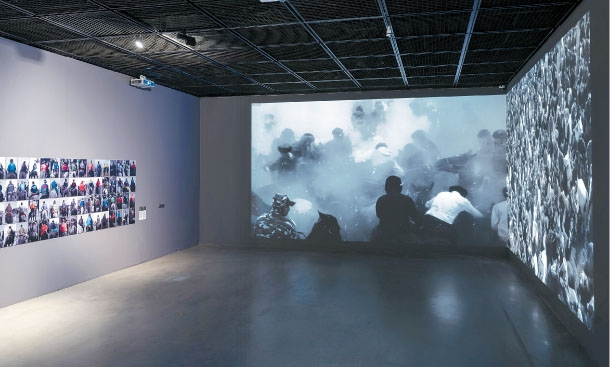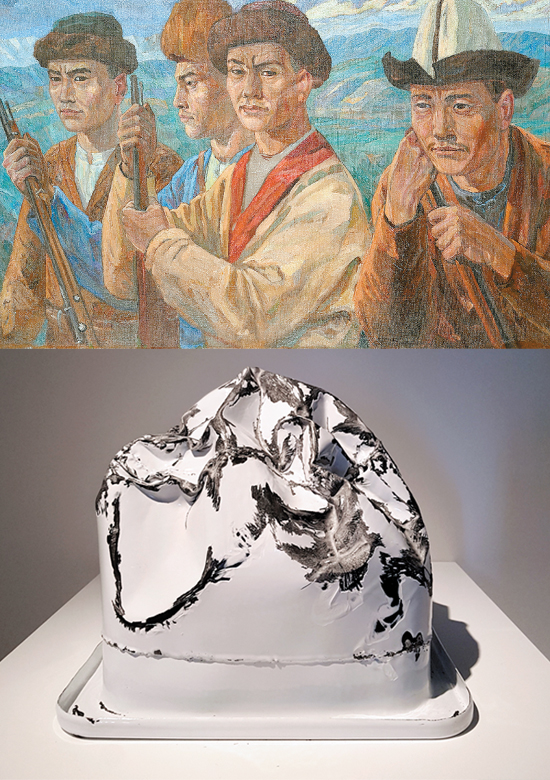Through art and history, Kazakhstan shares its story: Central Asian nation defines itself at exhibits in Seoul and Gyeonggi

The last part of the “Focus Kazakhstan - Eurasian Utopia: Post Scriptum” held at the Suwon iPark Museum of Art in Suwon, Gyeonggi, features works by contemporary Kazakhstani artists, such as the pictured work “Steppe Wolves” (2017) by Said Atabekov. [SUWON IPARK MUSEUM OF ART]
Both exhibitions opened on Nov. 27 - one at the National Museum of Korea, central Seoul, titled “Kazakhstan: The Cradleland of the ‘Golden Man’” and another at the Suwon iPark Museum of Art in Suwon, Gyeonggi, titled “Focus Kazakhstan - Eurasian Utopia: Post Scriptum.” Historical artifacts from the faraway country are on display at the national museum, while the exhibit in Suwon provides visitors a look at some of Kazakhstan’s modern and contemporary art.
The Suwon exhibition comes as a part of the “Focus Kazakhstan” project, a global project launched by the Kazakhstani government to promote its culture globally. There are currently four cities hosting “Focus Kazakhstan” exhibits: London, Berlin, Jersey City and Korea’s very own Suwon.
An overview of the country’s modern and contemporary art, the project was launched by the National Museum of Republic of Kazakhstan and the Ministry of Culture and Sports, after Kazakhstan’s President Nursultan Nazarbayev gave orders to “spread our culture and art to the other world,” according to Abay Satubaldin, the deputy director of the country’s national museum. Referring to an article published by the Kazakhstani president in April 2017 titled “Course towards the future: Modernization of Kazakhstan’s identity,” Satubaldin explained the process of the country’s largest-ever culture project.
It was President Nazarbayev’s “intention to spread the cultural and artistic heritages of Kazakhstan to other countries across various fields of culture. For us, in the art field, we decided to start ‘Focus Kazakhstan’ to concentrate on the art field. This exhibition is a part of that project, to introduce the art world of Kazakhstan - a country that sits in the center of Central Asia,” said Satubaldin to local press on Nov. 28.
Some 400 pieces of modern and contemporary art by 90 artists hang on the walls at galleries in the four different cities around the world, including 110 works by 50 artists that are on display in Suwon. In the two-part exhibition, visitors get to learn about the country’s history through their modern art, and how the young minds of Kazakhstan perceive the world as we know it now through contemporary pieces in the second part.

The “Kazakhstan: The Cradleland of the ‘Golden Man’” exhibition at the National Museum of Korea features old artifacts from Kazakhstan, such as carpets, top, and a reconstruction of the Saka chieftain’s clothing, above. [SUWON IPARK MUSEUM OF ART]
Even to this day, the ethnic composition of the country is as diverse as it could get. While a half of the population are Kazakhs, a quarter are Russian, followed by Polish, Ukrainian, German, Tatar, Uyghur and Korean. Within the artwork on display is the chaos, the harmony and the historical hardships suffered by the country and expressed by artists who have lived through tumultuous times, especially during the 20th century.
According to Shin Eun-young, the curator of the exhibition, Kazakh art embodies both the traditional aesthetics of the past and the avant-garde progressiveness of Russia. The country came under Soviet rule in 1925, and it wasn’t until World War II when modern art really started to bloom. Only when intellects and people in creative fields fled to Kazakhstan during and after the war did art and free expression start to build its foundations.
For instance, “Warriors of Amangeldy” (1956) by Pavel Zaltsman, is experimental, but based in the classic medium of painting. His pointillist-like method with oil gives a watercolor-like texture to his work. Other significant names include Eugeny Sidorkin, Sergey Kalmykov and Mikhail Kim.
In the 1980s, Kazakh art began to take shape as the region started to form its own identity.
“The Soviet Union opened itself up to the outside world, bringing change to the diverse corners of the Kazakhstani society,” explained curator Shin. “When the country gained independence in 1991, it came face to face with new paradigms and ideas. Their old frame of thought [about ideas] such as political ideology or nationality was replaced by norms of the society such as social order and gender.”
Salihitdin Aitbayev’s “A Girl in a National Costume” (1977), Boris Pak’s “Kinetic Still Life. Kylkobyz II” (1982) and Abdrashit Sydykhanov’s “A Dog Eating Its Puppies” (1989) display these changes that took place. Art became more than just a means of expressing beauty, but a vessel to question society.

The “Focus Kazakhstan” exhibition is a chance to see Kazakhstani art from the mid-20th century, when modern art just started to bloom, like “Warriors of Amangeldy” (1956) by Pavel Zaltsman, above, and contemporary works like Yerbossyn Meldibekov’s “Lenin Peak” (2017), below. [SUWON IPARK MUSEUM OF ART, YOON SO-YEON]
The 40 works that sit in the second part allow visitors to see how those efforts have been created, such as Alexander Ugay’s expression on movement and stillness - representing the endless repetition of nomadic life. Ugay’s “Pulota (Obscuration #5)” (2017), Rustam Khalfin’s “Pulota” (1991-2001), Yelena and Victor Vorobyev’s “Red Carpet” (2011) and Said Atabekov’s “Steppe Wolves” each represent contemporary thoughts and touch on issues from different perspectives.
The “Kazakhstan: The Cradleland of the ‘Golden Man’” exhibit at the National Museum of Korea present around 450 artifacts and relics from prehistoric times to as early as the modern era. Kazakhstan is known for its rich minerals and natural resources, namely gold. The golden artifacts, just as the modern artworks, display a Eurasian ambience that gives Korean visitors a chance to see something both familiar and unfamiliar at the same time.
According to Satubaldin, the deputy director of the Kazakh national museum, the exhibit is part of a six-part project that forms the country’s “Course towards the future.” The first part is the exhibitions, which are dedicated to spreading Kazakh culture and art to the world. This also includes art and historical exhibitions, as well as stage productions overseas.
The second project is the most long-term one, which is to change its current writing system into one that uses the Latin alphabet. The country currently uses Kazakh as its primary language along with Russian, and uses Cyrillic characters for writing. The government will keep its linguistic composition the same, but change the alphabet to the Latin system, by teaching young students to learn how to write using the Latin alphabet starting in 2025. This will be made possible through another project, in which the government will take 100 must-read books from various fields to make new school textbooks to learn from.
Other projects include the “100 Faces of Kazakhstan,” in which the government selects 100 people who have succeeded in heightening Kazakh culture for the next generation; analyzing the country’s geography and choosing the top 100 sites for tourism and cultural experience, as well as regions that carry significant meaning; and finally, putting on a series of cultural programs across the country to raise awareness of Kazakh identity to its people.
“We hope that, through this exhibition, you’ll get to understand more of our culture,” said Satubaldin. “We’ve brought works by famous and young artists alike for you to enjoy. This will be an opportunity to bring the two countries closer and learn more about each other.”
BY YOON SO-YEON [yoon.soyeon@joongang.co.kr]










with the Korea JoongAng Daily
To write comments, please log in to one of the accounts.
Standards Board Policy (0/250자)